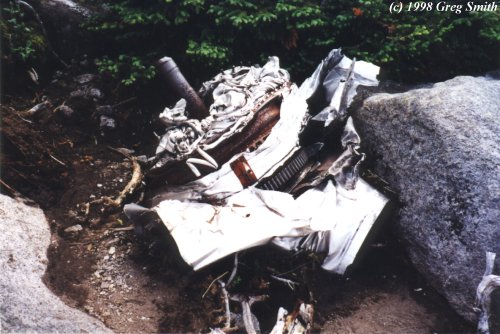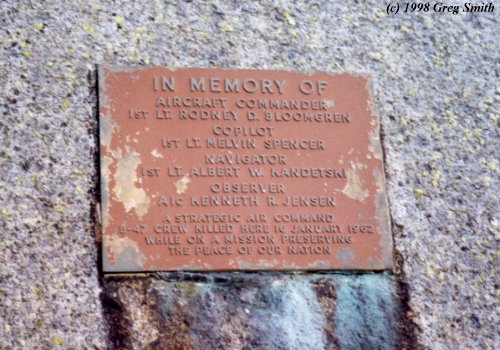B-47 Crash in the High Peaks (original) (raw)
An Air Force Bomber Crashes into Wright Peak
The headline in the Wednesday, January 17, 1962, edition of the Jamestown_Post-Journal_ read "Local Flier's Plane Lost." Jamestown native First Lt. Rodney D. Bloomgren was in command of a jet-powered B-47E strategic bomber, part of the 380th Bombardment Wing out of Plattsburgh Air Force Base, during a training mission early the previous morning. The bomber radioed Plattsburgh, located immediately west of Lake Champlain, at 2am on January 16, and was never heard from again. The training mission was to practice low-altitude bombing runs over Watertown, an oft-used target for Plattsburgh bombers, possibly due to Watertown's close proximity to the Army installation at Fort Drum. Watertown is located between Lake Ontario and the Adirondack wilderness, nearly 150 miles from Plattsburgh.
 |
|---|
| A piece of B-47 wreckage near the summit of Wright Peak. |
Due to the low-altitude nature of the training run, the crew had been out of radio contact since leaving Watertown. Therefore, when the plane failed to appear in Plattsburgh at 7am when expected, no one had any idea where it was. An enormous search effort was commenced across all of northern New York and other northeastern states, involving not only the US Air Force but the Royal Canadian Air Force as well. Perhaps the plane had overshot Plattsburgh and had crashed into Lake Champlain or Vermont. Perhaps it had continued over Watertown and had gone down in Lake Ontario. Perhaps it just exploded without a trace. No one knew for sure, but everyone seemed to have an answer: hundreds of reports came in from citizens everywhere claiming to have seen and heard explosions at all times during the night. One man reported a huge hole in the ice covering a lake near his home, possibly large enough to accomodate a bomber. Odd tracks in the snow and skid marks on icy lakes were seen. Low-flying planes, barely high enough to clear the trees they were flying over, were seen everywhere. Hundreds of planes must have crashed that night! Each and every lead had to be checked out, and each and every one came up empty. Day after day, the hopes of finding survivors amongst the four crew members waned. Finally, more than four days after the crash occurred, pieces of wreckage were found in the Adirondack High Peaks by a searchplane.
Part of a wing was found, as well as three opened parachutes, in the col between Algonquin Mt. and Wright Peak. The parachutes had not been opened by the crew members; the chutes, as well as a self-inflating life raft that was also aboard, apparently opened up during the crash. Adirondack Loj became the basecamp for the Air Force ground search effort, and a road was plowed to Marcy Dam, two miles into the wilderness. Over the course of the next several days, repeated efforts were made to search the area between Algonquin and Wright for any possible survivors, although the outlook was bleak. It was the dead of winter in the High Peaks, and searchers were constantly battling heavy snow - reportedly up to 20 feet - and high winds near the summits (I can personally attest to the ferocity of the wind on these peaks in January - see Point #12 of my "Now I've Seen It All..." page). Any unprepared person left out in those conditions could surely not survive long. The remains of two of the men, Lt. Bloomgren and the co-pilot, 1st Lt. Melvin Spencer, were found by searchers about a week after the wreckage was discovered. The remains of the navigator, 1st Lt. Albert W. Kandetski, were found later; Airman 1st Class Kenneth R. Jensen's remains were never found. In fact, Jensen was not even supposed to be aboard that particular training mission. He was filling in for another crew member who
 |
|---|
| Plaque placed by the 380th Bomb Wing near the impact site. |
had become ill prior to the flight. According to the bronze plaque placed at the crash site on Wright, Jensen's function was "observer". He had no official function on the flight; as part of his training he was required to sit in on a certain number of these missions and observe. This was to be his last such required flight.
The plane had apparently veered about 30 miles off course on its return trip to Plattsburgh due to inclement weather and high winds, and ventured into the High Peaks. Again, due to a lack of both radio and radar contact with the bomber, it was impossible for the ground crew to know that the plane was off course, let alone warn the pilots. Wright is the 16th tallest mountain in the Adirondacks, at 4580 feet. The bomber was heading in a southwest direction when it just clipped the top of the peak, mere feet from the summit. One might think "if only they were a bit higher..." Unfortunately, had the plane continued on its course, it would have soon come across Mt. Marcy, the tallest mountain in New York State, and nearly one thousand feet taller than Wright. There would have been no escape.
Upon impact with the mountain, the jet-engined plane, which had no doubt been traveling at high speed, essentially shattered, spreading wreckage well down the southwest side of the Peak and into the col between Algonquin and Wright. Pieces of debris can still be seen just below the summit, easily found by hikers ascending the mountain. What appears to be part of an engine (pictured above) can be found very near the site of the plaque placed in memory of the crew members who lost their lives here. There is also a large metal shaft of some sort at the same spot near the plaque, as well as various other pieces of debris, including lots of twisted sheet metal. Hikers also report finding pieces of wreckage well below the summit while ascending Wright via a slide on the southwest side of the mountain, attesting to the power with which the plane struck the peak. The plaque placed near the summit reads:
IN MEMORY OF
Aircraft Commander
1st Lt. Rodney D. Bloomgren
Copilot
1st Lt. Melvin Spencer
Navigator
1st Lt. Albert W. Kandetski
Observer
A1C Kenneth R. Jensen
A Strategic Air Command
B-47 Crew Killed Here 16 January 1962
While On A Mission Preserving
The Peace Of Our NationAs a side note, Plattsburgh AFB was officially closed in 1994 as part of the Air Force's Base Realignment program of 1993, and is now a business and industrial park.
Thank you very much to Kristi Davis for her compilation of back issues of the Jamestown, NY Post-Journal regarding her cousin, 1st Lt. Rodney Bloomgren.
Go back to main History page.